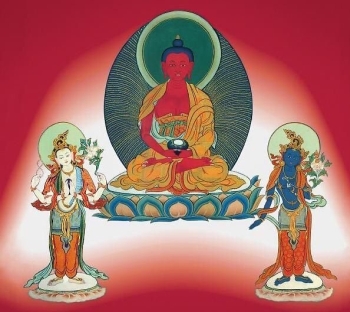Amitabha - Buddha of Limitless Light
We have to speak about Buddha Amitābha or Buddha of Limitless Light, when we talk about Buddhist concepts on death.
In the last article we were reviewing omens and signs that are preceding the death and now we can tell what is expected to happen next.
In Tibetan Buddhism and some other Mahāyāna traditions, especially the Pure Land Buddhism, widely spread in China, Japan and a few other Asian countries,
it is believed that after a death all Bodhisattvas, Realized ones and those who have practiced Buddhism and been familiar with the inner bg-sky light of Buddha consciousness are going to the Pure Land of Buddha Amitābha.
His name means "Limitless Light" - Amita (unmeasured, boundless, infinite) + ābha (splendour, light; colour, appearance, beauty).
In Tibetan Vajrayāna Buddhism Amitābha is considered one of the 5 Dhyāna Buddhas (together with Akṣobhya, Amoghasiddhi, Ratnasambhava and Vairocana) or 5 wisdoms of the Buddha.
In the sūtras it has been said the Pure Land of Amitābha, known also with a name Dewachen (in Tibetan) or Sukhāvatī (in Sanskrit) is a land or energy-field somewhere very far away in western direction, in some other planetary system.
All Enlightened Beings are reborn there when they leave the human body.
There are several Sūtras narrating about Amitābha and his Pure Land and its inhabitants, from which the most important are considered 3:
- Longer Sukhāvatī-vyūha Sūtra
- Shorter Sukhāvatī-vyūha Sūtra
- Amitāyurdhyāna Sūtra
In the Infinite Life Sūtra or Longer Sukhāvatī-vyūha Sūtra (Sanskrit: सुखावतीव्यूहः Sukhāvatī-vyūha) Buddha has described to his devotee Ānanda the past lives of Buddha Amitābha:
In his past life Buddha Amitābha has been once a king who renounced his kingdom and became a Bodhisattva Dharmakāra ("Dharma Storehouse").
He was meditating for 5 eons as a Bodhisattva under the guidance of the Buddha Lokeśvarāja (“World Sovereign King”) who was the Buddha of that age.
Innumerable Buddha-lands in ten directions were revealed to him. After this Buddha Amitābha made many noble vows to save all sentient beings from all sufferings.
And through his great merits he created a realm named Sukhāvatī (“Ultimate Bliss”) also known as a Pure Land of Amitābha.
The Sūtra contains the 48 great vows of Amitābha and elaborately narrates about the Pure Land, its inhabitants and how they were able to attain rebirth there.
Amitābha in his other form is also known as Buddha Amitāyus, as a Buddha-aspect we meditate upon for a long life.
Buddha Amitābha can bring us all enlightened qualities, but it is especially important to be concentrated upon him at the moment of death. And to prepare ourselves for a death we use to meditate upon Amitābha and repeat his mantra.
In Tibetan Buddhism we usually visualize Amitābha in a dark red ruby colour above our head, above crown chakra. He is radiating everywhere around him a bright ruby-colour energy field.
On his right hand is sitting Bodhisattva Chenrezig, on his left – Bodhisattva Vajrapāṇi. They are the closest disciples of Amitābha.
When we meditate this way, we can repeat the mantra of Buddha Amitābha:
It is recommended to repeat this mantra at least 111’111 times.
Often it is also a preparation requirement for another, even more powerful, Amitābha practice – Phowa - a conscious dying practice when we send our consciousness into the heart of red Buddha, experiencing what exactly does happen at the moment of death.
But phowa practice is strongly forbidden to try on one’s own; it should be learned under direct guidance of a qualified Lama. Nowadays courses of Phowa are held periodically also in the west.
Other than that people are often asking how they can help their dying loved ones:
Even if during a life someone hasn’t reached the enlightenment, there is still a good chance they can accomplish it in an after-death state, if they can keep visualizing the ruby-red radiating Buddha above their head.
It is recommended to tell them about it.
Or if they are already unable to understand anything or keep concentration, we should meditate and visualize Buddha Amitābha above their head and how their consciousness go up the energy channel to the crown chakra and shoots into the heart of Amitābha.
In Tibet it is also a common tradition to read aloud to the dying person after the death the Tibetan Book of the Dead, where are described all states of consciousness he should go through and be not afraid.
Even if the body of a person seems dead, he is still there near his body for the next approximately 40 days and can see and hear what is told.
P.S. You can get a better understanding about Amitabha reading the Buddha Amitabha Sutra


